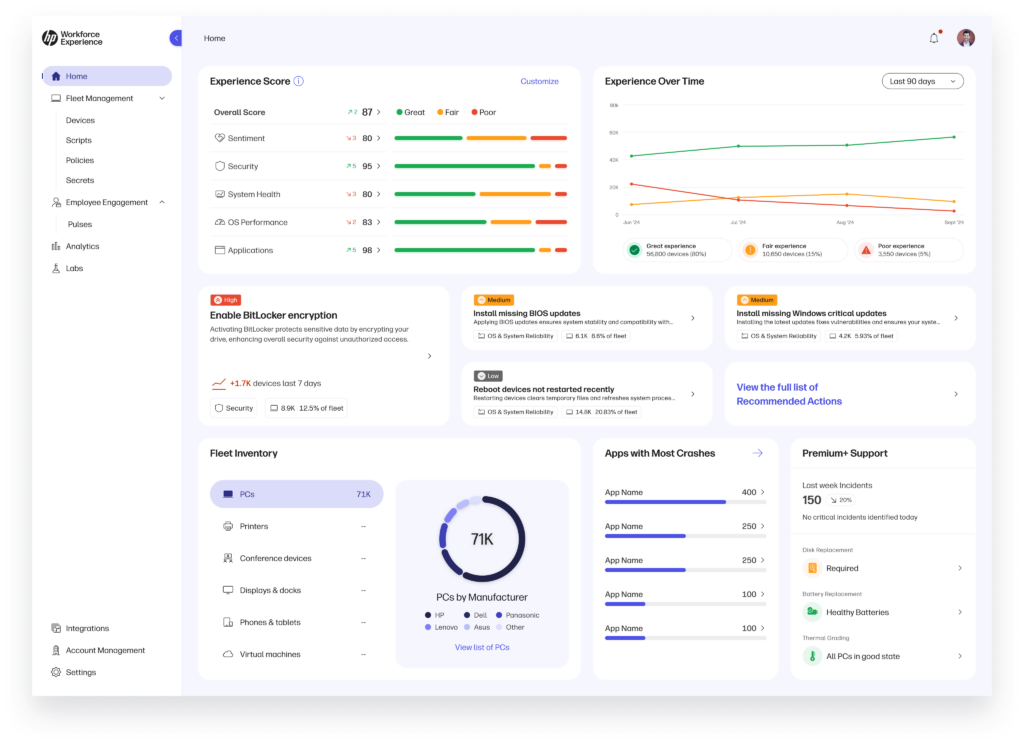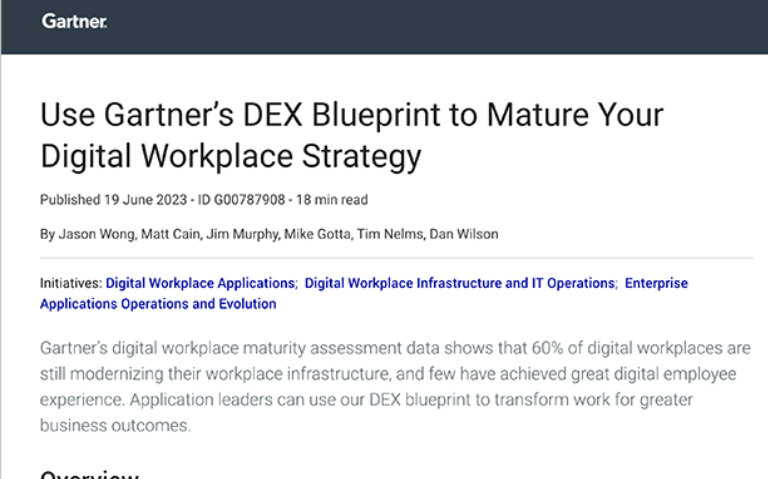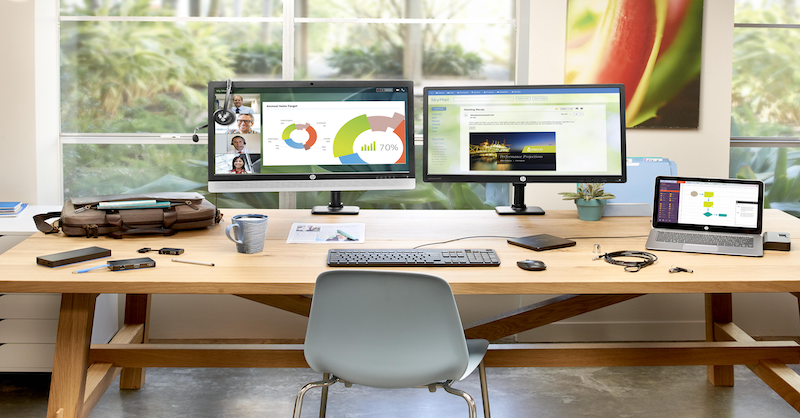Digital Employee Experience
What Is Digital Employee Experience (DEX)?
Everything you need to know to build your DEX strategy. Discover how to optimize technology, streamline processes, and create a workplace where your employees can thrive.
DEX defined
Digital Employee Experience (DEX) refers to how employees interact with workplace technology, including digital tools, IT systems, and technology infrastructure. It’s not just about having access to technology; it’s about how intuitive, efficient, and supportive these tools are in helping employees perform their daily tasks.
A comprehensive DEX solution considers every aspect of an employee’s interaction with their digital environment—from PCs, printers, and peripheral devices to applications and other enterprise software.

Why is DEX important?
An optimized DEX reduces digital friction and allows employees to perform at their best. When employees have seamless access to the tools they need and encounter fewer technical issues, their productivity naturally improves. The result is a workforce that feels empowered and engaged, knowing they can rely on their digital resources to support their work.
What challenges impact the digital employee experience?
With the rise of hybrid and remote work, employees today face an uphill battle as digital friction and IT challenges continue to grow. Onboarding alone is a challenge, but employees also have to navigate a maze of devices, operating systems, applications, networks, and cloud environments. Meanwhile, IT teams are overwhelmed with support tickets because they lack the necessary tools to address issues quickly and effectively. As a result, companies are struggling to manage DEX across the organization, let alone improve or optimize it. Some of the challenges include:
-
Technology issues
Slow, outdated, or poorly optimized devices disrupt productivity and frustrate employees. Just 28% of knowledge workers have a healthy relationship with work1.
-
Disconnected systems
Fragmented and often siloed solutions that only address specific needs lead to poor visibility, inefficiency, and a disjointed experience. 68% of knowledge workers are seeking a personalized work environment1.
-
Limited support
Delays or gaps in IT support disrupt workflows and lower employee satisfaction. 70% of knowledge workers say it’s important to be able to work in the way that best suits their needs1.

What are the key benefits of optimizing the digital employee experience?
A well-optimized digital employee experience (DEX) starts with data. By leveraging telemetry from various touchpoints, companies can create a seamless connection between employees and the tools they rely on. It empowers IT teams to proactively address challenges while boosting engagement and productivity. Here are some key benefits of optimizing DEX with data-driven insights:
Automating tasks like asset tracking, software updates, and compliance checks allows IT teams to save time and focus on strategic initiatives. The result is smoother workflows, faster response times, and higher employee productivity across hybrid work environments.
Enhanced communication through tailored notifications, pulse surveys, and self-help tools fosters better engagement between IT and employees. These efforts boost employee satisfaction, trust, and adoption of IT solutions, improving the overall digital workplace experience.
Detailed insights into device usage and energy consumption help organizations implement eco-friendly IT strategies. Employees are empowered to adopt sustainable practices, reducing the environmental impact of technology use across the enterprise.
Must-have DEX features
There are many digital employee experience (DEX) platforms available, but not all DEX solutions are created equal. To truly elevate employee satisfaction and productivity, your platform should include these essential features:
-
Seamless automation and usability
Traditional platforms require IT teams to manually extract and correlate data across various systems for actionable insights. Modern DEX solutions automate this process, delivering pre-analyzed insights and recommendations in real-time, reducing the reliance on external tools. Ease of use empowers IT teams to act faster and focus on strategic priorities.
-
Device catalog and persona matching
Modern platforms allow organizations to create a custom catalog of devices that are tailored to their needs and match these devices to user personas based on AI-driven usage behavior analysis. This ensures the right devices are deployed to the right employees, optimizing performance and user satisfaction.
-
Unified IT investment management
Outdated solutions focus solely on PC management. Modern platforms take a holistic view of IT investments by integrating PCs, peripherals, printers, and collaboration tools into a single dashboard, providing comprehensive visibility and management of the entire IT ecosystem.
-
AI-driven device refresh recommendations
Intelligence-backed refresh cycles analyze device usage patterns, age, warranty status, and other metrics to recommend whether to replace, refurbish, or upgrade the device fleet. This removes the burden of manual data exports and analysis, saving IT teams time and ensuring smarter decisions.

What makes the HP Workforce Experience Platform (WXP) a visionary in DEX?
The HP Workforce Experience Platform has been recognized as a “Visionary” and a “Major Player” in the DEX space. Leveraging HP’s deep expertise in hardware, software, and services, the Platform integrates tools into a single, AI-powered ecosystem. By unifying fleet management, employee engagement, digital workspaces, and endpoint security into a single solution, HP empowers organizations to streamline operations, remove friction, enhance collaboration, and provide employees with highly personalized digital experiences.
Learn more about WXP
Discover how WXP transforms your IT from reactive to proactive, solving problems before they arise.
DEX Toolkit
Ready to gain visibility and control over your entire digital ecosystem? Use these resources to calculate the potential value to your business and build your DEX strategy.
Frequently asked questions about DEX
Your questions answered.
Digital Employee Experience (DEX) refers to how employees interact with the digital tools, platforms, and systems they use daily. It encompasses ease of access, reliability, and how well these technologies support productivity, collaboration, and overall satisfaction.
The digital workforce experience is the collective experience employees have when engaging with digital tools in their work environment. This includes everything from devices and applications to collaboration platforms and IT support systems—all working together to enhance efficiency and job satisfaction.
DEX is measured through metrics like employee productivity, system reliability, application usage, and satisfaction surveys. Advanced analytics, such as telemetry data and AI-driven insights, help monitor performance and identify areas for improvement in real-time.
A DEX team focuses on optimizing the employee’s digital experience by managing devices, applications, and workflows. They use data and feedback to address pain points, improve technology adoption, and ensure tools align with employees’ needs and business goals.
The modular design allows companies to select the capabilities or modules, needed to achieve business goals. New modules can be added to an existing portal as their business needs change and expand. Initially, WXP comes with two modules for fleet management and employee engagement, with the ability to add-on endpoint security and digital workplaces for an additional fee.
Sign up for our DEX newsletter
Get the latest DEX news, tips, and strategies delivered straight to your inbox.







